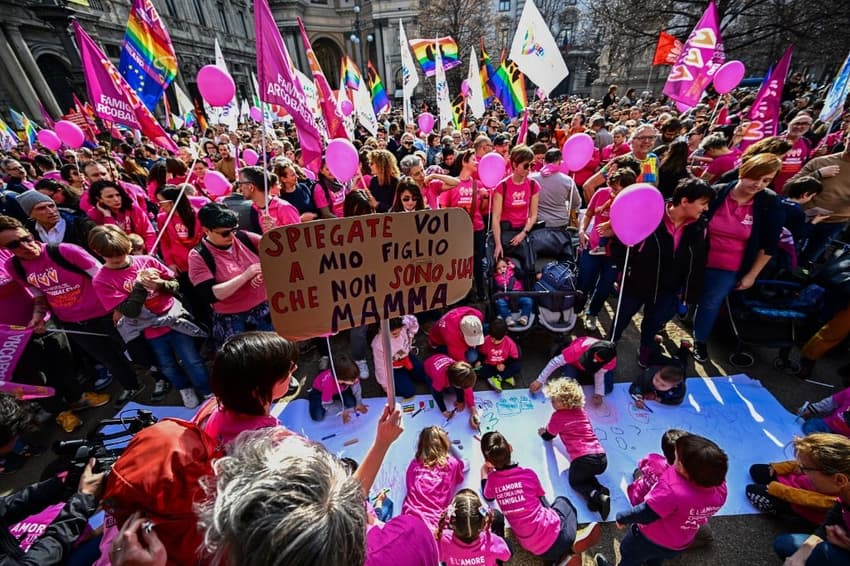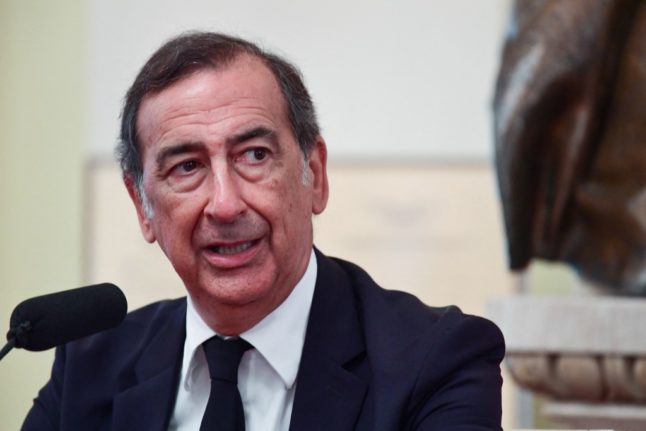Protesters gather in Milan as Italy limits same-sex parents' rights

Hundreds of people took to the streets of Milan on Saturday in protest against a new government directive stopping local authorities from registering the births of same-sex couples' children.
"You explain to my son that I'm not his mother," read one sign held up amid a sea of rainbow flags that filled the northern city's central Scala Square.
Italy legalised same-sex civil unions in 2016, but opposition from the Catholic Church meant it stopped short of granting gay couples the right to adopt.
Decisions have instead been made on a case-by-case basis by the courts as parents take legal action, although some local authorities decided to act unilaterally.
Milan's city hall had been recognising children of same-sex couples conceived overseas through surrogacy, which is illegal in Italy, or medically assisted reproduction, which is only available for heterosexual couples.
But its centre-left mayor Beppe Sala revealed earlier this week that this had stopped after the interior ministry sent a letter insisting that the courts must decide.
READ ALSO: Milan stops recognising children born to same-sex couples
"It is an obvious step backwards from a political and social point of view, and I put myself in the shoes of those parents who thought they could count on this possibility in Milan," he said in a podcast, vowing to fight the change.

Milan's mayor Giuseppe Sala has assured residents that he will fight to have the new government directive overturned. Photo by Miguel MEDINA / AFP
Fabrizio Marrazzo of the Gay Party said about 20 children are waiting to be registered in Milan, condemning the change as "unjust and discriminatory".
A mother or father who is not legally recognised as their child's parent can face huge bureaucratic problems, with the risk of losing the child if the registered parent dies or the couple's relationship breaks down.
Elly Schlein, newly elected leader of the centre-left Democratic Party, was among opposition politicians who attended the protest on Saturday, where many campaigners railed against the new government.
Prime Minister Giorgia Meloni, whose Brothers of Italy party came top in the September elections, puts a strong emphasis on traditional family values.
"Yes to natural families, no to the LGBT lobby!" she said in a speech last year before her election at the head of a right-wing coalition that includes Matteo Salvini's anti-immigration League.
Earlier this week, a Senate committee voted against an EU plan to oblige member states to recognise the rights of same-sex parents granted elsewhere in the bloc.
Comments
See Also
"You explain to my son that I'm not his mother," read one sign held up amid a sea of rainbow flags that filled the northern city's central Scala Square.
Italy legalised same-sex civil unions in 2016, but opposition from the Catholic Church meant it stopped short of granting gay couples the right to adopt.
Decisions have instead been made on a case-by-case basis by the courts as parents take legal action, although some local authorities decided to act unilaterally.
Milan's city hall had been recognising children of same-sex couples conceived overseas through surrogacy, which is illegal in Italy, or medically assisted reproduction, which is only available for heterosexual couples.
But its centre-left mayor Beppe Sala revealed earlier this week that this had stopped after the interior ministry sent a letter insisting that the courts must decide.
READ ALSO: Milan stops recognising children born to same-sex couples
"It is an obvious step backwards from a political and social point of view, and I put myself in the shoes of those parents who thought they could count on this possibility in Milan," he said in a podcast, vowing to fight the change.

Fabrizio Marrazzo of the Gay Party said about 20 children are waiting to be registered in Milan, condemning the change as "unjust and discriminatory".
A mother or father who is not legally recognised as their child's parent can face huge bureaucratic problems, with the risk of losing the child if the registered parent dies or the couple's relationship breaks down.
Elly Schlein, newly elected leader of the centre-left Democratic Party, was among opposition politicians who attended the protest on Saturday, where many campaigners railed against the new government.
Prime Minister Giorgia Meloni, whose Brothers of Italy party came top in the September elections, puts a strong emphasis on traditional family values.
"Yes to natural families, no to the LGBT lobby!" she said in a speech last year before her election at the head of a right-wing coalition that includes Matteo Salvini's anti-immigration League.
Earlier this week, a Senate committee voted against an EU plan to oblige member states to recognise the rights of same-sex parents granted elsewhere in the bloc.
Join the conversation in our comments section below. Share your own views and experience and if you have a question or suggestion for our journalists then email us at [email protected].
Please keep comments civil, constructive and on topic – and make sure to read our terms of use before getting involved.
Please log in here to leave a comment.